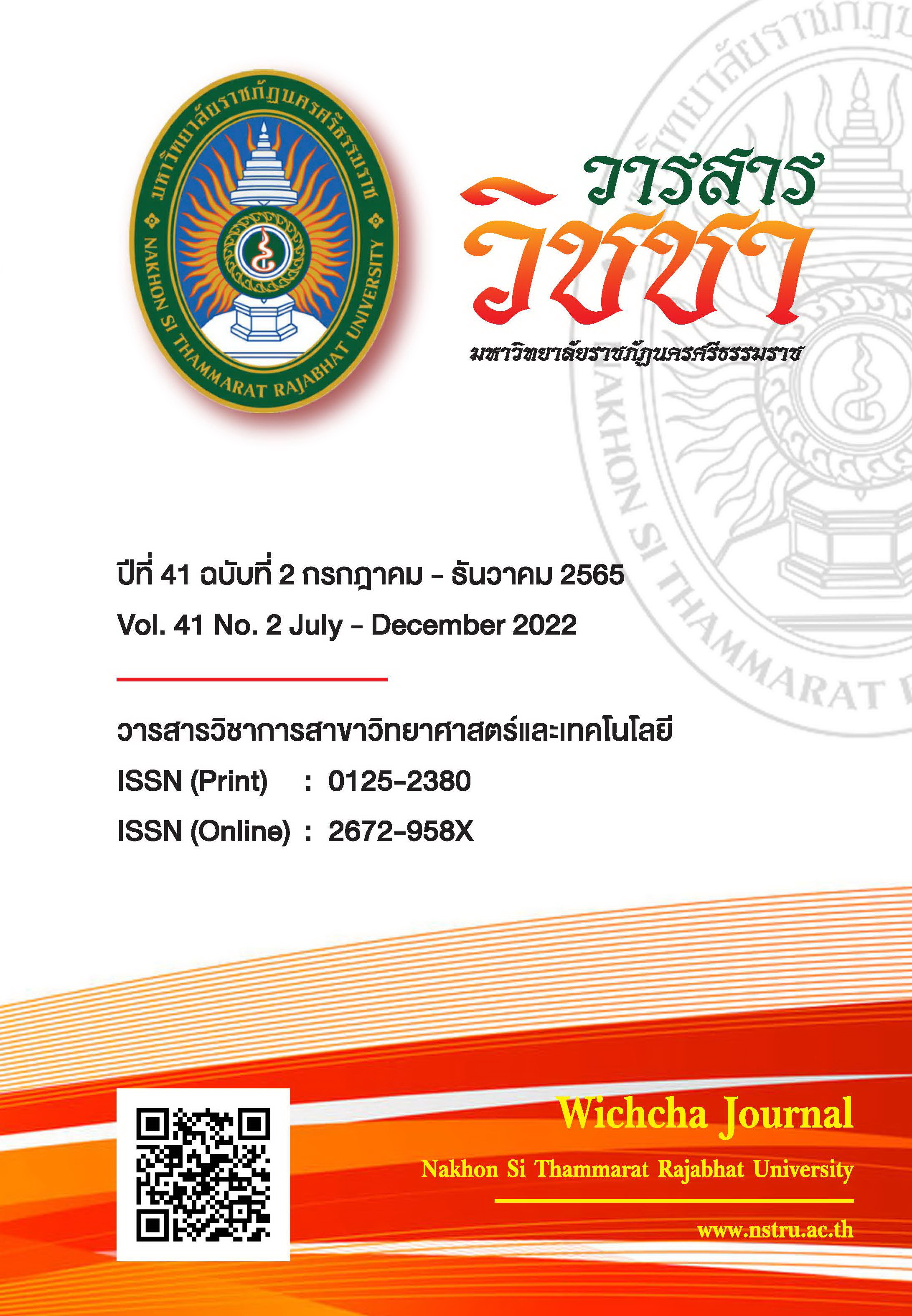The Growth and Yield of Asiatic Pennywort from 5 Accessions in a Hydroponic System
Main Article Content
Abstract
This research aims to study the growth and yield of Asiatic pennywort from 5 accessions, including Prachinburi, Ubon Ratchathani, Rayong, Nakhon Pathom and Nakhon Si Thammarat. The plants were cultivated in a deep flow technique (DFT) hydroponic system using commercial nutrient solution, namely Stock Solution A and B. The experiments were conducted at the Thailand Institute of Scientific and Technological Research, Khlong Ha, Khlong Luang, Pathum Thani. Experimental method was carried out using a randomized complete block design (RCBD) with 5 treatments and 3 replications. The plant growth was recorded every 10 days for a period of 60 days after planting. Results showed that Asiatic pennywort collected from Nakhon Pathom, Prachinburi and Ubon Ratchathani provinces had the highest number of leaves per plant (8.00 7.95 and 7.29 leaves, respectively). Ubon Ratchathani accessions had the highest petiole length (21.53cm), whereas Nakhon Si Thammarat, Rayong, Nakhon Pathom and Ubon Ratchathani accessions had the highest root length (16.99 16.50 16.43 and 14.94 cm, respectively). The highest number of plants per stolon was found in Rayong and Ubon Ratchathani accessions (9.77 and 7.44 plants, respectively). Nakhon Pathom accessions had the highest stolon length (159.32 cm), whereas, the highest average fresh weight yield per area was found in Prachinburi, Rayong, Nakhon Pathom and Ubon Ratchathani accessions (263.00 258.67 242.67 and 223.67 g, respectively). However, leaf greenness values (SPAD), number of stolons per plant and leaf area of 5 accessions were not statistically different. Therefore, Prachinburi accessions are suitable for growing under a hydroponic system.
Article Details

This work is licensed under a Creative Commons Attribution-NonCommercial-NoDerivatives 4.0 International License.
เนื้อหาและข้อมูลในบทความที่ลงตีพิมพ์ในวารสารวิชชา มหาวิทยาลัยราชภัฏนครศรีธรรมราช ถือเป็นข้อคิดเห็นและความรับผิดชอบของผู้เขียนบทความโดยตรง ซึ่งกองบรรณาธิการวารสารไม่จำเป็นต้องเห็นด้วยหรือร่วมรับผิดชอบใด ๆ
บทความ ข้อมูล เนื้อหา รูปภาพ ฯลฯ ที่ได้รับการตีพิมพ์ในวารสารวิชชา มหาวิทยาลัยราชภัฏนครศรีธรรมราช ถือเป็นลิขสิทธ์ของวารสารวิชชา มหาวิทยาลัยราชภัฏนครศรีธรรมราช หากบุคคลหรือหน่วยงานใดต้องการนำข้อมูลทั้งหมดหรือส่วนหนึ่งส่วนใดไปเผยแพร่ต่อหรือเพื่อการกระทำการใด ๆ จะต้องได้รับอนุญาตเป็นลายลักษณ์อักษรจากวารสารวิชชา มหาวิทยาลัยราชภัฏนครศรีธรรมราชก่อนเท่านั้น
The content and information in the article published in Wichcha journal Nakhon Si Thammarat Rajabhat University, It is the opinion and responsibility of the author of the article. The editorial journals do not need to agree. Or share any responsibility.
References
กรมส่งเสริมการเกษตร. (2558). การปลูกผักไฮโดรโปนิกส์. กรุงเทพฯ: โรงพิมพ์ชุมชนสหกรณ์เกษตรแห่งประเทศไทย.
จันทรพร ทองเอกแก้ว. (2556). บัวบกสมุนไพรมากคุณประโยชน์. วิทยาศาสตร์และเทคโนโลยี มหาวิทยาลัยอุบลราชธานี. 15(3), 70-75.
จิรพันธ์ ศรีทองกุล. (2553). อิทธิพลความแก่ใบ ความเข้มแสง และอุณหภูมิต่อการเปลี่ยนแปลง ปริมาณสารเอเซียติโคไซด์และคุณภาพบัวบก Centella asiatica (L.) Urban. วิทยานิพนธ์ปรัชญาดุษฎีบัณฑิต (เทคโนโลยีหลังการเก็บเกี่ยว). มหาวิทยาลัยเทคโนโลยีพระจอมเกล้าธนบุรี. กรุงเทพฯ.
นวลศรี รักอริยะธรรม และอัญชนา เจนวิถีสุข. (2545). แอนติออกซิเดนท์ สารต้านมะเร็งในผักสมุนไพรไทย. เชียงใหม่: นพบุรีการพิมพ์.
บุษกร ฟิตประยูร. (2559). สถานการณ์การผลิตพืช 2558/59. รายงานวิจัย. กรมส่งเสริมการเกษตร.
ประนอม ใจอ้าย. (2556). วิจัยและพัฒนาเทคโนโลยีการผลิตบัวบก. รายงานวิจัย. ศูนย์วิจัยและพัฒนาการเกษตรแพร่.
สมชาย เชื้อจีน. (2543). การจําแนกสายพันธุ์และหาเทคโนโลยีที่เหมาะสมในการเพิ่มผลผลิตบัวบก. วิทยานิพนธ์วิทยาศาสตรมหาบัณฑิต (พืชสวน). มหาวิทยาลัยขอนแก่น, ขอนแก่น.
หนึ่งฤทัย ด่านเขตร์แดน คมกฤษณ์ แสงเงิน อนันต์ พิริยะภัทรกิจ และณัฐพงค์ จันจุฬา. (2564). การเจริญเติบโตและผลผลิตของบัวบกจากห้าแหล่งปลูกในระบบไฮโดรโปนิกส์. ใน การประชุมทางวิชาการของมหาวิทยาลัยเกษตรศาสตร์ ครั้งที่ 59 (หน้า 321-327). กรุงเทพฯ: มหาวิทยาลัยเกษตรศาสตร์.
อนันต์ พิริยะภัทรกิจ ประภาพร ตั้งกิจโชติ และปิยะ เฉลิมกลิ่น. (2552). การผลิตบัวบกในระบบเกษตรอินทรีย์. วารสารวิทยาศาสตร์เกษตร, 40(3), 205-208.
อนันต์ พิริยะภัทรกิจ พรกมล รูปเลิศ กนกอร อัมพรายน์ และณัฐพงค์ จันจุฬา. (2562). การศึกษาลักษณะสัณฐานวิทยาของบัวบกสายพันธุ์ต่าง ๆ. Thai Journal of Science and Technology, 8(1), 1-12.
Chew, Y.L., Lim, Y.Y., Omar, M. and Khoo, K.S. (2008). Antioxidant activity of three edible seaweeds from two areas in South East Asia. LWT - Food Science and Technology, 41(6), 1067-1072, doi: https://doi.org/10.1016/j.lwt.2007.06.013.
Daduang, J., Vichitphan, S., Daduang, S., Hongsprabhas, P. and Boonsiri, P. (2011). High phenolics and antioxidants of some tropical vegetables related to antibacterial and anticancer activities. African Journal of Pharmacy and Pharmacology, 5(5), 608-615, doi: https://doi.org/10.5897/AJPP10.243.
Hashim, P. (2011). Centella asiaticain food and beverage applications and its potential antioxidant and neuroprotective effect. International Food Research Journal. 18(4), 1215-1222.
Zhao, D., Reddy, K.R., Kakani, V.G., and Reddy, V.R. (2005). Nitrogen deficiency effects on plant growth, leaf photosynthesis, and hyperspectral reflectance properties of sorghum. European Journal of Agronomy, 22(4), 391-403, doi: https://doi.org/10.1016/j.eja.2004.06.005.


